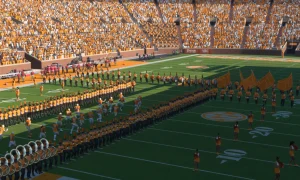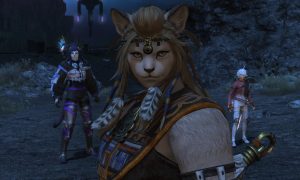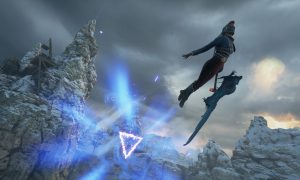I often imagine the planning meetings for RIFT by Trion Worlds going something like this: “Okay, guys. Everyone pick a game from the box and play it for six months. Then come back with everything you liked, and everything you didn’t, and we’ll go from there.”
To be honest though, the folks at Trion Worlds have been working on the title for nearly five years before releasing it in early March. The road hasn’t been smooth, as they were sued last year by Palladium Games over the name ‘Rift: Planes of Telara’, which prompted the name change to simply RIFT after the lawsuit was dropped. They also created insane amounts of buzz by doing beta events instead of an extended beta.
Trion Worlds also wasn’t shy about taking shots at the proverbial 800-pound gorilla, World of Warcraft, using advertising showing off the feature the game was named for with the tagline: We’re not in Azeroth Anymore.
So with all of this in mind, let’s take a look at how RIFT holds up under the spotlight after nearly two months in play.
The story of RIFT depends on which side you’re on. The basics are the same: The world of Telara is a nexus between various planes. The Death God Regulous has broken the barriers separating those planes from Telara and invaded, before being stopped by the death of Aedraxis.
The Guardians are those who believe in the way of the Vigil, the gods of Telara. Twenty years after the death of Aedraxis, they have ressurrected the worthy fallen and gifted them with the power of the Ascended. The Defiants, however, are those who believe that everyone should have power, not just those who follow the gods. After an unknown number of years and after the Guardians failed to prevent Regulous from returning, the Defiant perfected a way to bring people back to life and gift them similar powers, as well as a time machine to send them back in time to the same point where the Guardians were returned to life.
Each side has three races: the Guardians have high elves, Mathosians (humans) and dwarves, while the Defiants have the Eth (humans), Bahmi (near giants) and the Kelari (think dark elves). Each side shares the same four classes: clerics, mages, thieves and warriors.
However, unlike most MMOs, RIFT doesn’t lock each class into the standard tank/dps/healing roles. Each class has nine souls that you can unlock, and mix and match each of them into up to four different roles (soon to be five). Each role can take three of the souls to build a custom class, meaning you have up to 84 different possible class builds. This also means that you can have a mage tank, a rogue healer, and a cleric DPS. While some builds may (and do) do better than others at various tasks, it doesn’t mean that you have to wait for a cleric to heal a dungeon, or a warrior-tank to help you through it. This flexibility is unparalleled, and also may minimize the disease known as alt-itis.
However, you don’t immediately start with everything. You gain your primary soul early on, then gain two more in the tutorial area. Once you’re in the first zone, though, you can quest to get five of the remaining six souls, with the final one requiring PVP in order to achieve.
Trion Worlds wastes little time throwing you into the thick of the action. By the time you’ve finished the tutorial (around level five to seven) you’re already fighting in rifts. Each of the game’s zones is immense, giving you plenty of room to explore and either do quests or search for dynamically created rifts. Of course, leaving the rifts alone isn’t always an option, as they can spawn invasions which move directly for the towns, intent on destroying the quest givers, merchants and healers.
To be honest, one of the most exhilarating moments of the first day I played was seeing the sky over Silverwood (the Guardian opening zone) going black and announcements of an impending invasion. Checking the map showed at least 20 black rifts opening up. Not only that, all of the monsters appeared to be level 18-19, much outstripping my poor level 7 self. However, fighting off the invaders was actually fun, and the rewards were awesome. It was definitely possible to contribute at lower levels, which means that the rifts are fun for all levels. To be blunt, it’s the best hour of gaming I’ve had in years.
Gameplay in RIFT gives players many options. You can either quest for experience, levels and loot, or you can take time off to go hunt down rifts and invasions for experience, levels, and different loot. After level 10, you can also dive into PVP (opening up a new area every ten levels) and gain experience, levels, and favor (with which to buy different loot) as well. There are quests involving rifts and PVP as well. Not only that, there are crafting quests for those of us who enjoy that sort of thing.
The game’s rifts are dynamically generated at random intervals. Invasions come much less often, but have multiple stages involving a series of rifts and invasions, ending with a boss invader to take down. These boss fights usually require multiple 20-man raids.
One of the best things about the rifts and questing in general is the ease with which you can join another group or raid without hunting. If you’re near a rift or invasion, you can click the handy ‘join public group’ button which will automatically put you in a group with anyone nearby who is set to public. You can also right-click on a player’s portrait and choose ‘join public group’ to easily take down quest objectives without worrying about stealing from other players. This is an example of Trion Worlds taking an idea from another MMO (the Public Quests from WAR) and tweaking it, improving it and finally making it their own.
The one real drawback with the ‘join public group’ concept is that your group or raid can splinter in the middle of an event. However, you can’t simply leave the group, then join a nearby one instead. Doing this will instead put you back into the same splintered group. Granted, group/raid leaders can merge and unmerge public groups, but if you’re not a leader, you’re pretty much stuck.
Crafting is very similar to other MMOs. You’ve got a number of gathering skills (mining, foraging and butchery) and creation skills (apothecary, armorsmithing, weaponsmithing, artificing and outfitting). There’s also Runecrafting, which is very similar to WoW’s enchanting. You can take up to three skills at a time, and you learn your recipes from trainers as you level your skill. Of course, there are rare recipes which are drop-only and some which are from quests and from token turn-ins as well. The zones have some crafting areas while each side has all of the crafting areas in their capital city. The items you gain through crafting are easily as good if not sometimes better than drops you get from questing. Some rift and PVP items can be better than crafted, but it definitely doesn’t mean that crafted items are junk.
That said, through the first 33 levels of the game, I’ve seen very few non-green items. I’ve seen blue items by turning in items gained through fighting rifts, and a couple of purple items gained by other token turn-in opportunities. Drops from monsters and quests, however, have been universally green for me. While I know the other items are out there, it does make me wonder if the RNG needs to be tweaked somewhat. It definitely makes those blue and more rare items that much more special. Or, it would if there was a definite difference in stats between the various levels of rarity.
The PVP zones range from simple ‘get the item and hold it’, to capture points, flag capture and other options. Each PVP zone has seperate tiers, each ranging within a 10-level gap. Those who aren’t at max level are temporarily buffed to make things more even across the board. Each zone has its own strategy and goal, and what works in one place may not work in another. Through the fighting as well as through various quests you gain favor in various factions, which is then used to purchase items from that faction’s vendors.
Each zone has a dungeon as well, with quests that lead you through it. Also, when you are at max level, you can run ‘expert mode’ dungeons with increased difficulty and better loot. Here is where you’ll find the game’s best loot, along with the end game’s rifts. The rifts in the end game content feature both 10-man and 20-man raids, and Trion Worlds has been doing a good job at adding new content over the course of the first month or so, and have another big patch forthcoming.
Adding into all of the things to do with the game, RIFT also has achievements for each zone, dungeon and so on. This ties into one of the most unique things that RIFT has going for it. Unlike any other MMO to date, RIFT is intimately tied into social media. From launch, any time you unlocked an achievement, the game not only announces it locally and to your guild, but also gives you the ability to set up your Twitter account in-game and tweet the achivement with a link to a screenshot that the game automatically takes. With Patch 1.1 RIFT added the ability to film Youtube videos on the fly, and with 1.2 will add the ability to send Facebook updates. While other games and third-party applications have given you the ability to do this, nothing to date has incorporated social media to this extent.
Rounding out some of the things you can do in-game are collections. Taking a page from Everquest 2, RIFT gives you the opportunity to find items for a number of collections. These are all lore-specific and can be turned in for both token and monetary rewards, as well as bags of supplies now and again. The tokens can be used for a variety of things, from non-combat pets, bits of gear that are only for showing off, or a special mount which is only available here.
While most of this review has been highly positive, the game is not flawless. It’s (currently) missing any way to easily look for a group, although we’re told this is coming in patch 1.2. As mentioned before, the public group needs some definite tweaking, which hopefully will be picked up down the line.
Ron Burke is the Editor in Chief for Gaming Trend. Currently living in Fort Worth, Texas, Ron is an old-school gamer who enjoys CRPGs, action/adventure, platformers, music games, and has recently gotten into tabletop gaming.
Ron is also a fourth degree black belt, with a Master's rank in Matsumura Seito Shōrin-ryū, Moo Duk Kwan Tang Soo Do, Universal Tang Soo Do Alliance, and International Tang Soo Do Federation. He also holds ranks in several other styles in his search to be a well-rounded fighter.
Ron has been married to Gaming Trend Editor, Laura Burke, for 28 years. They have three dogs - Pazuzu (Irish Terrier), Atë, and Calliope (both Australian Kelpie/Pit Bull mixes), and an Axolotl named Dagon!

See below for our list of partners and affiliates:
























